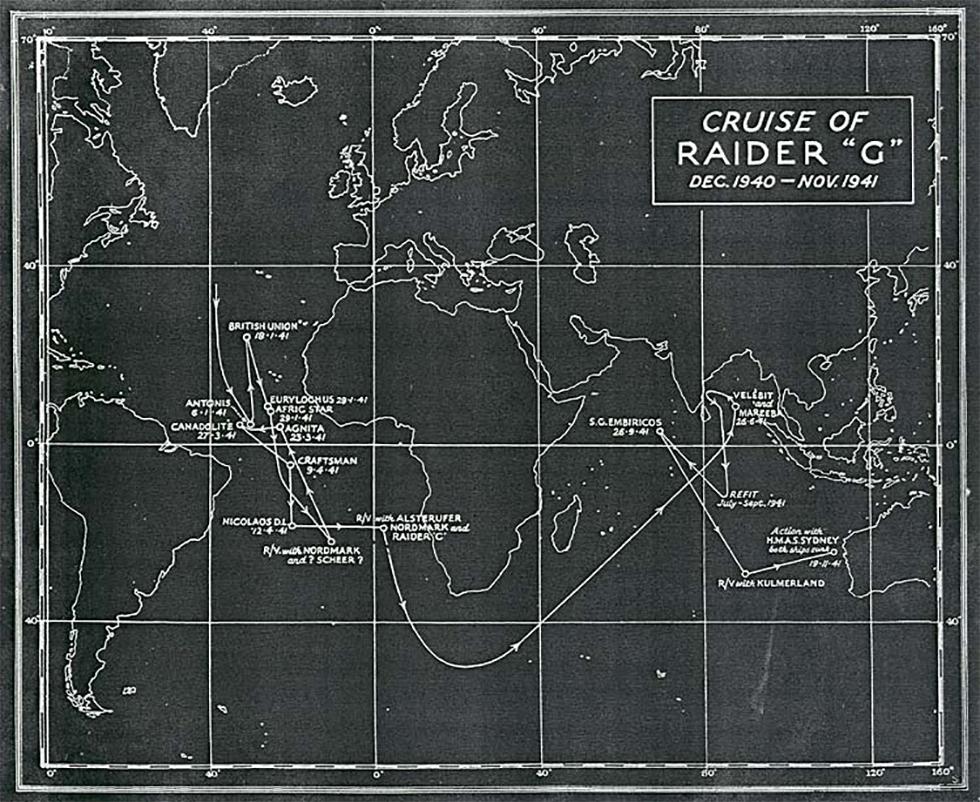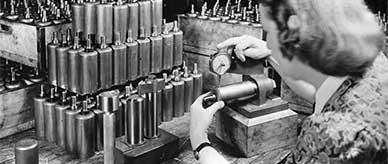


Transcript
[A nautical chart, with a line drawn to show the path of ‘Raider G’. The page is labelled:] CRUISE OF RAIDER “G” Dec. 1940 – Nov. 1941
[There are several labelled circles marked on the route to show interactions with other ships. The route begins in the northern Atlantic Ocean, and there are ten circles marked in that region.]
ANTONIS 6.1.41
BRITISH UNION 18.1.41
EURYLOCHUS 29.1.41
AFRIC STAR 29.1.41
R/V with NORDMARK and ? SCHEER ?
AGNITA 23.3.41
CANADOLITE 27.3.41
CRAFTSMAN 9.4.41
NICOLAOS D.I. 12.4.41
R/V with ALSTERUFER NORDMARK and RAIDER ‘C’
[The route then goes around the south coast of Africa to the Indian ocean, ending near the west coast of Australia. Five more points are marked in the Indian Ocean.]
VELEBIT and MAREEBA 26.6.41
REFIT July – Sept. 1941
S.G. EMBIRICOS 26.9.41
R/V with KULMERLAND
Action with H.M.A.S. SYDNEY both ships sunk 19.11.41
About this record
This is a nautical chart showing the route of the German auxiliary cruiser Kormoran, which was known as 'Raider G'. The chart shows the route the ship took across the Atlantic and Indian oceans during its operations between December 1940 and November 1941. The circles represent the locations of ships the Kormoran either sank or captured, as well as rendezvous between the Kormoran and other ships. Fifteen separate incidents are recorded.
Educational value
- The chart is part of Australian naval historical records connected with the sinking of the HMAS Sydney by the German raider Kormoran in one of Australia's most significant naval catastrophes. All 645 crew on the Sydney were lost when it was destroyed during the attack in November 1941, although this could not be confirmed at the time. The Kormoran also sank after the battle, scuttled by her crew, of whom 317 survived the engagement.
- On the chart the Kormoran is identified as 'Raider G', a name given to it by the British Admiralty. The ship was originally built as a merchant vessel and designated Schiff 41 by the German navy. In October 1940 Schiff 41 was redeployed as a merchant raider with a crew of 397 and renamed the Kormoran. She had a maximum speed of around 18 knots, and after her conversion had a heavy armament.
- The chart shows the route of the Kormoran during operations in the Atlantic and Indian oceans. Most of the action occurred in the Atlantic, with the chart showing that seven ships were destroyed and one ship was captured between January and April 1941. After a refit that took several months, the Kormoran attacked a second smaller cluster of ships in the Indian Ocean, before being sunk in November that year.
- During World War II, Germany used disguised and armed merchant ships known as 'raiders' to attack unescorted allied merchant ships and to lay mines on shipping routes used by the Allies. At the time of the attack on the Sydney, the Kormoran had been posing as the Dutch freighter Straat Malakka for just over a year. Her attacks on British and Allied ships were an important part of Germany's war effort to disrupt the vital supply of goods to Allied countries.
- Details of the battle were originally pieced together from interviews with Kormoran survivors, including Captain Theodor Detmers, who revealed that the Sydney had approached his ship and asked him to provide the secret call sign, which the real Straat Malacca should have known. Detmers then opened fire, and in the ensuing battle, the Sydney was heavily damaged and sank later that night. The Kormoran was hit in the engine room and abandoned due to the spread of fire.
- Wreckage of both the Kormoran and Sydney were discovered in 2008. That same year a Department of Defence Commission of Inquiry was established to look into the circumstances of the loss of HMAS Sydney. No-one saw the Sydney sink, but Detmers and some of his crew saw her sail slowly away towards the coast of Western Australia, on fire from stem to stern. The last glimpse they had of her was a glow which disappeared several hours later.
Acknowledgments
Learning resource text © Education Services Australia Limited and the National Archives of Australia 2010.
Related themes
Need help with your research?
Learn how to interpret primary sources, use our collection and more.


